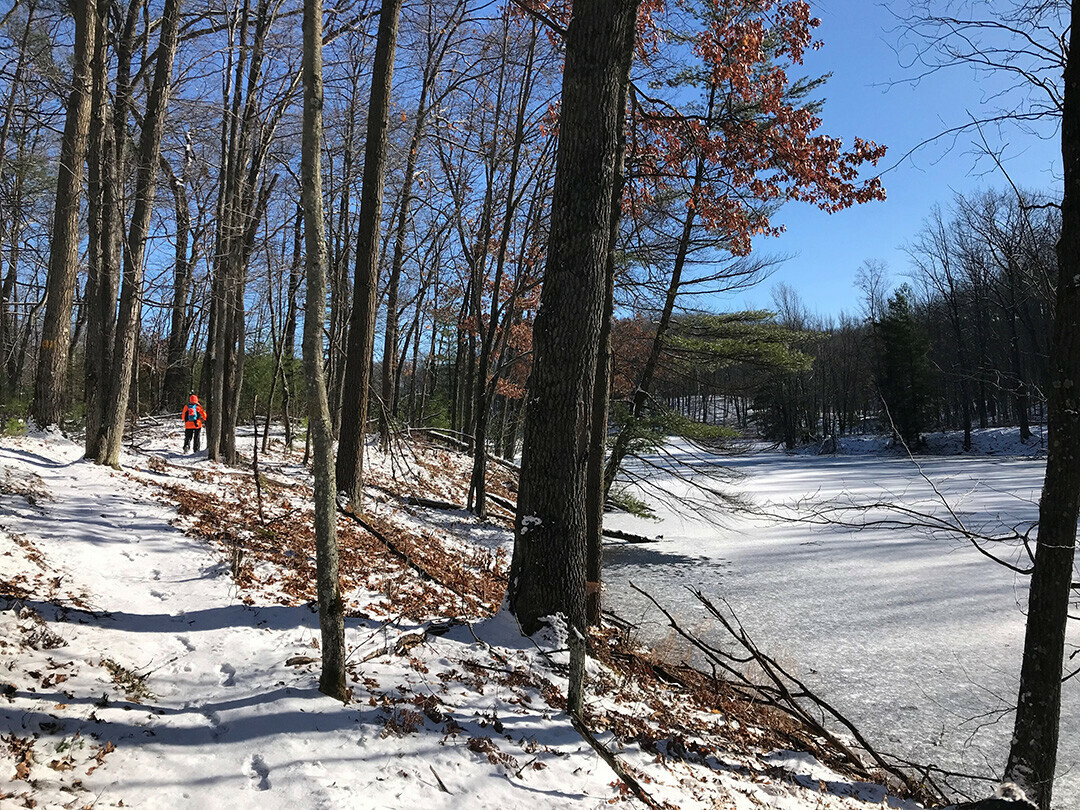Putting the ‘Ice’ in Ice Age Trail
now officially a national park, the Ice Age Trail draws visitors in wintertime, too

Move over, Yellowstone. Step aside, Yosemite. There’s a new national park – and it runs right through the Chippewa Valley.
The Ice Age National Scenic Trail was officially declared a national park in December by the National Park System. The 1,200-mile-long trail – which zig-zags through some of the state’s best scenery along the edge of the last continental glacier – was one of three scenic trails to get an upgrade from the NPS.
The Ice Age, New England, and North Country national scenic trails had previously been established by Congress and were already administered by the National Park Service as part of the National Trails System. So what does the change in designation really mean? Put simply, it will bring access to more federal funding, said Sen. Tammy Baldwin, D-Wis., who pushed for the NPS move.

“With this new designation, Wisconsin trails will be included in all the great lists that publicize our nation’s national treasures,” Baldwin said, “and be considered for more funding opportunities that allow their managers and many volunteers to take good care of them.”
While the change in status might not immediately mean much for day-to-day users, it opens to the door to new sources of federal grant funding, said Melissa Pierick, director of marketing and community relations for the Ice Age Trail Alliance, the nonprofit group that manages the trail alongside the NPS and the Wisconsin Department of Natural Resources.
“With this new designation, Wisconsin trails will be included in all the great lists that publicize our nation’s national treasures,” Baldwin said, “and be considered for more funding opportunities that allow their managers and many volunteers to take good care of them.”
While the change in status might not immediately mean much for day-to-day users, it opens to the door to new sources of federal grant funding, said Melissa Pierick, director of marketing and community relations for the Ice Age Trail Alliance, the nonprofit group that manages the trail alongside the NPS and the Wisconsin Department of Natural Resources.
“We have variety of boardwalks and bridges along the trail, they all have certain lifespans, and now we can apply for funding to get those structures rebuilt,” she said. Nonetheless, the Ice Age Trail Alliance will still be raising money and relying on volunteers from 19 regional chapters who help build and maintain the trail.
WINTER MAGIC
While outdoors enthusiasts may first think of hitting the trail in summer or fall, the Ice Age Trail is open 365 days a year, and there are plenty of people who enjoy the beauty – and challenge – of traversing it during the colder months.
“The trail is really great during the winter,” said Pierick, who has hiked portions of the trail – including the Chippewa Moraine Segment in northern Chippewa County – during that season. While many people think only of summertime when it comes to hiking, traveling the trail when it’s colder has a number of advantages, she said: There are no ticks or mosquitoes, and instead of muddy the ground is hard and frozen. In addition, winter hikers are treated to scenic vistas that are otherwise hidden by foliage.

Naturally, snow creates its own challenges. When snow is deep on the trail, hikers may end up “postholing” – sinking up to their knees or hips with each step – which makes traveling on the trail slow and tiring. As a result, many wintertime hikers use snowshoes, Pierick said. She advises that would-be winter hikers also keep an eye on social media and reach out to the appropriate regional Ice Age Trail volunteer chapters to learn about local trail conditions.
In some places, Pierick added, the Ice Age Trail runs parallel to groomed cross-country ski trails. In these cases, she explained, hikers should practice good trail etiquette and avoid trampling on areas with groomed ski tracks.
Winter is also a good time for Ice Age Trail aficionados to walk the trail’s connecting routes – the roughly 500 miles that link yellow-blazed trail segments – many of which follow plowed rural roads, she said.
For the truly dedicated, perhaps a wintertime thru-hike is in order: In March 2021, Emily Ford of Duluth, Minnesota, became the first woman – and only the second person – to thru-hike the whole trail during winter, which she did alongside a borrowed Alaskan Husky.
WORLD CLASS TRAIL
Whatever the season, the change in federal status will likely bring more attention to the Ice Age Trail – which traces its roots to the 1950s and was officially established by an act of Congress in 1980.
“Unit status gives the trail, and its volunteers, the recognition it duly deserves,” Luke Kloberdanz, executive director and CEO of the Ice Age Trail Alliance, said in early December. “Make no mistake: the Ice Age Trail is world-class and the number of hours alliance volunteers devote to it consistently rank among the top in all the National Park Service.”
The Ice Age Trail begins near St. Croix Falls and winds its way east, south, and then north again to end in Sturgeon Bay. It passes through 30 of Wisconsin’s 72 counties, including the northern portion of Chippewa County.
One of the other trails to be reclassified – the North Country National Scenic Trail – also includes a Wisconsin segment: The 4,800-mile trail from North Dakota to Vermont crosses through far northern Wisconsin, including the Chequamegon-Nicolet National Forest.
Learn more about the Ice Age National Scenic Trail from Ice Age Trail Alliance at iceagetrail.org.

